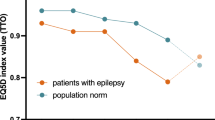Abstract
Assessment of health-related quality of life (HRQOL) has been developed to the point where well‐validated instruments are being used in clinical trials. Data on the impact of new treatments can be used for formulary and regulatory decisions if the clinical trials are designed with appropriate instruments and sample sizes. However, more information is needed about the clinical significance of small differences in total or scale scores. Similarly, pharmacoeconomic studies should be prospective assessments that include evaluation of HRQOL as well as cost. In the future, these new aspects of outcome assessment are expected to be used as an adjunct to traditional seizure frequency and adverse effect reports in the selection of antiepileptic drugs.
Similar content being viewed by others
References
Cramer JA, Smith DB, Mattson RH, et al. A method for quantification for the evaluation of antiepileptic drugs in adults. Neurology 1983;33(Suppl. 1. 1): S26–S37.
Duncan JS, Sander JWAS. The Chalfont seizure severity scale. J Neurol Neurosurg Psychiatry 1991;54: 973–876.
Baker GA, Smith DF, Morrow J, Crawford PM, Chadwick DW. The development of a seizure severity scale as an outcome measure in epilepsy. Epil Res 1991;8: 245–51.
Aldenkamp AP, Baker GA, Pieters MSM, Schoemaker HC, Cohen AF, Schwabe S. The Neurotoxicity Scale: The validity of a patient-based scale, assessing neurotoxicity. Epil Res 1995;20: 29–39.
Cramer, JA. Quality of life for people with epilepsy, Neurologic Clinics: Epilepsy II: Special Issues, ed. O Devinsky, WB Saunders Company, New York, 1994A;12: 1–13.
World Health Organization. The first 10 years of the World Health Organization. Geneva: WHO, 1958.
Schipper H, Clinch J, Powell, V. Definitions and conceptual issues. In: Spilker B, ed. Quality of Life Assessments in Clinical Trials. New York: Raven Press, 1990: 11–24.
Perrine K, Hermann BP, Meador KJ, Vickrey BG, Cramer JA, Hays RD, Devinsky O. The relationship of neuropsychological functioning to quality of life in epilepsy.Arch Neurol 1995; 52: 997–1003.
Hermann BP, Whitman S. Behavioral and personality correlates of epilepsy: a review, methodological critique, and conceptual model. Psychol Bull 1984;95: 451–97.
Jacoby A. Epilepsy and the quality of everyday life: findings from a study of people with well-controlled epilepsy. Soc Sci Med 1992;34: 657–66.
Cramer JA. Quality of Life Assessments in Epilepsy. In: Spilker B, ed. Quality of Life and Pharmacoeconomics in Clinical Trials, Philadelphia: Lippincott-Raven Publishers, 1996: 909–18.
Spilker B. Quality of Life and Pharmacoeconomics in Clinical Trials, Philadelphia: Lippincott-Raven Publishers, 1996.
Hunt S, Mc Kewan J, Mc Kenna SP. The Nottingham Health Profile: User's Manual, 1981.
Ware JE, Sherbourne CD. A 36-item short form health survey (SF-36). I. Conceptual framework and item selection. Med Care 1992;30: 473–83.
Hays RD, Sherbourne C, Mazel E. The RAND 36-item health survey 1.0. Health Econ 1993;2: 217–27.
Smith DF, Baker GA, Dewey M, Jacoby A, Chadwick DW. Seizure frequency, patient-perceived seizure severity and the psychosocial consequences of intractable epilepsy. Epil Res. 1991;9: 231–41.
Baker GA, Smith DF, Dewey M, Jacoby A, Chadwick DW. The initial development of a health-related quality of life model as an outcome measure in epilepsy. Epil Res 1993;16: 65–81.
Jacoby A, Baker GA, Dewey M, Chadwick DW. Measuring the impact of epilepsy: the development of a novel scale. Epil Res 1993;16: 83–8.
Baker GA, Jacoby A, Smith DF, et al. Development of a novel scale to assess life fulfillment as part of the further refinement of a quality of life model for epilepsy. Epilepsia 1994;35: 591–6.
Chaplin JE, Yepez R, Shorvon S, Floyd M. A quantitative approach to measuring the social effects of epilepsy. Neuroepidemiology 1990;9: 151–8.
Vickrey BG, Hays RD, Graber J, Rausch R, Engel J, Brook RH. A health-related quality of life instrument for patients evaluated for epilepsy surgery. Med Care. 1992;30: 299–319.
Devinsky O, Vickrey BG, Cramer JA, Perrine K, Hermann B, Meador K, Hays RD. Development of the quality of life in epilepsy (QOLIE) inventory. Epilepsia 1995;36: 1089–104.
Cramer JA, Perrine K, Devinsky O, Vickrey BG, Meador K, Hermann BP, Bryant-Comstock L. Development of a 31-item quality of life in epilepsy inventory (QOLIE-31) and cross-cultural translations. Epilepsia 1997;38. (in press).
Cramer JA, Perrine K, Devinsky O, Meador K. A brief questionnaire to screen for quality of life in epilepsy: The QOLIE-10. Epilepsia, 1996;37: 577–82.
Cramer JA, Devinsky O, Westbrook L, Perrine K, Hermann B, Camfield C, et al. Adaptation of an epilepsy quality of life instrument for adolescents. Epilepsia 1995;36 (Suppl. 4): 93.
Wagner AK, Keller SD, Kosinski M, Baker GA, Jacoby A, Hsu MA, et al. Advances in methods for assessing the impact of epilepsy and antiepileptic drug therapy on patients' health-related quality of life. QOL Res 1995;4: 115–34.
Smith D, Baker G, Davies G, et al. Outcomes of add-on treatment with lamotrigine in partial epilepsy. Epilepsia 1993;34: 312–22.
Vickrey BG, Hays RD, Engel J, Spritzer K, Rogers WH, Rausch R, et al. Outcome assessment for epilepsy surgery: The impact of measuring health-related quality of life. Ann Neurol 1995;37: 158–66.
Johnson A. Some statistical issues in quality of life measurements. In: Trimble MR, Dodson WE, eds. Epilepsy and Quality of Life. New York: Raven Press. 1994: 65–84.
Cockerell OC, Hart YM, Sander JWAS, et al. The cost of epilepsy in the United Kingdom: An estimation based on the results of two population-based studies. Epil Res 1994;18: 249–60.
Begley CE, Annegers JF, Lairson DR, et al. Cost of epilepsy in the United States: A model base on incidence and prognosis. Epilepsia 1994;35: 1230–43.
Author information
Authors and Affiliations
Rights and permissions
About this article
Cite this article
Cramer, J.A. Quality of Life as an Outcome Measure for Epilepsy Clinical Trials.. Pharm World Sci 19, 227–230 (1997). https://doi.org/10.1023/A:1008607109347
Issue Date:
DOI: https://doi.org/10.1023/A:1008607109347




